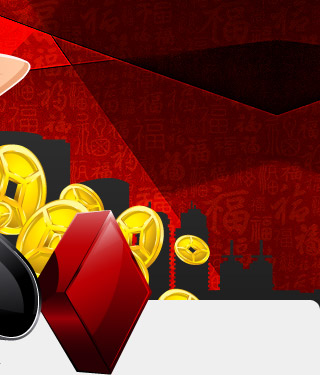Blackjack
History of Blackjack
Though blackjack originated in France, it has been one of the most popular table games in America for decades. Originally played as "21", the game was never as popular in the early American clubs and gambling houses as was poker or craps.
To increase interest in the game, some of the card rooms began to offer higher payouts for certain hands of cards; players who received an ace of spades with a jack of clubs or a jack of spades received a 10:1 bonus. Thereafter the game of 21 became known as blackjack because of those two cards.
The game of blackjack remained more or less unchanged until the 1960's when mathematician Edward Thorpe proved that the house edge could be virtually eliminated. With the help of computers, Thorpe and his colleagues calculated the most advantageous way to play every possible card combination.
Based on this research, a set of moves known as basic strategywas developed, and then modified by experts over the years. Basic strategy led casinos to develop countermeasures to control losses, and today you will find slight variations in blackjack rules depending on the casino you are in.
Blackjack Game Play
In blackjack your objective is to beat the dealer in one of two ways. You can either accumulate a higher score than the dealer without going over 21, or sit on a lower score and hope that the dealer goes over or busts.
All face cards (jacks, queens, kings) are given the value of 10, and an ace is worth either one or 11, depending on how you want to use it in your hand. Subsequently, any hand that contains an ace that is valued as 11 is called a soft hand as opposed to a hard hand which does not. The remaining cards are worth their face value.
The highest hand in the game is a blackjack or a natural, which is a two-card hand that totals 21. The player's hand can not be beat unless the dealer also has a blackjack, which in this case is called a push or a tie. Three or more cards totaling 21 may have the same value but do not beat out a natural 21.
The blackjack table in a casino is set up with five to seven betting spots with a dealer that acts for the house behind the table. The seat at the far left of the table is referred to as third base because it is the last seat to receive a card. Each table should have a plastic placard advertising the table limits and the minimum and maximum bets allowed at that particular time. You can exchange your money with the dealer for chips, but should not place your money in the betting circle as some casinos permit cash to play on the first bet.
Once you have your chips you can place your bet into the betting circle or box in front of you. Most casinos use multiple decks of two or more and can use as many as eight. After the dealer shuffles, a player will be asked to cut the deck. This duty is rotated from player to player in a clockwise motion after each shuffle. The dealer then inserts a colored cut card, about two-thirds the way into the deck so that he will not be tempted to deal down to the bottom. The dealer then places the cards into the shoe, or arranges them in his hand (for two or less decks). The dealer will then discard or burn the first card, and check to make sure that all players have their bets in the right place and in the right amount.
The dealer begins distributing the cards to the players from his left to right starting with the spot know as first base.
Each player will be dealt two cards face-up. The dealer receives an upcard dealt face-up and a hole card dealt facedown. Each player is playing a separate game, so after the dealer gives each player and himself two cards, he'll return to first base and start acting on each hand individually. As each players turn comes up he will point to their cards.
After receiving two cards, players must decide whether or not they would like to keep the hand as is, or take additional cards to increase the value of the hand. When you would like to be dealt another card, ahit or a draw is indicated by lightly scratching the table with your hand or cards. Every time you scratch the dealer will give you a card face-up; there are no limits to the number of hits a player can take.
If you do not want to take a card, you indicate a stand by waving your hand or placing your cards under your original bet. If you are lucky enough to be dealt an ace and a ten you have what is called a natural or blackjack and should immediately turn both cards face up to let the dealer know. The payout of 3:2 for a blackjack hand is standard in most casinos. If you take a hit and that card puts your total over 21, you lose automatically and the dealer removes your cards with your wager.
After all of the players have made their playing decisions, the dealer's hand is played out according to the rules of the house. What usually happens is that the dealer will reveal his hole card. If the dealer's hand totals 17 or more, he will stand. If the dealer's hand totals 16 or less, the dealer will hit until reaching 17 or more. At the end of the hand, if the totals of your cards are closer to 21, you win. If you win then you will be paid even money, the amount that you wagered, plus your original wager. If the dealer's hand is closer to 21, you lose and your wager goes to the house. If you have pushed, the dealer will rap the table with his knuckles and leave the chips where they stand. You are then allowed to increase, decrease or remove the bet.
Blackjack Playing Options
What makes the game of blackjack more entertaining is that sometimes you have the ability to increase your bets in mid-hand if you feel you have a good opportunity to win.
When presented with the opportunity to make these bets, you should take advantage of them because they help to eliminate the house edge.
One of the circumstances in which you may increase your bet is called doubling down. As the name implies, doubling down means that you are doubling your wager on the chance that you will win. You can double down only after looking at your first two cards; you cannot take a hit and then double down. In many casinos you can double down for less than what you originally wagered, some will allow you to double down on any two cards, and some will allow you to double down after splitting a pair. The only catch is that you must take one, and only one more card. The casino is essentially allowing you to make a second bet equal in size in exchange for the disadvantage of allowing only one more card for your hand.
Most players will double down when their first two cards total ten or 11. The reasoning behind this is that odds are good that their next card dealt will be a ten, giving a total of 20 or 21. Odds are in favor of receiving a 10-card because they are the most frequently occurring card being that all face cards have a value of ten. To tell the dealer you want to double down, you slide a second wager next to your original wager in the betting circle. Do not place the additional bet on top of the original wager, because the dealer may think you are trying to cheat by increasing your bet illegally. If you win your bet, you are paid even money for the two bets, and receive double your original wager. If you lose, both bets are taken away. In the event of a push, you keep both bets, but are not paid.
There is another option by which you can increase your original wager known as splitting. When you receive a pair, two cards of the same value such as two 8's, you are allowed to match your original bet and split the two cards into separate hands. Each card of the pair becomes the first card of an independent hand, with a wager that applies only to the hand to which it is attached. Split hands are then played out one after the other, both receiving an additional card and then following the route of hitting and standing. Because the two hands are independent, both hands may be lost, won, or a combination of the two.
To split a hand you place an identical bet next to your original bet. You may be allowed to split hands up to four times, but the rules concerning how many times you may do that vary from casino to casino. Splitting aces are special, for when you do, you receive only one card on each ace. If you obtain a blackjack on a split pair you will only be paid 1:1 for it is not a true blackjack (having not originally been dealt a two-card hand of 21).
Insurance is a side bet that the dealer has a natural, and it is only offered when the dealer's upcard is an ace. When the dealer has an ace card showing, it is assumed that the dealer could have a 10 card as their hole card. Each player is asked if they would like to insure their hands, and if they accept, the player must put up one-half of his original bet before play on anyone's hand commences. If the dealer does have a blackjack, then the insurance wager wins and the player is paid off at a rate of 2:1
One option that is not offered in all casinos is surrender. What this means is that you are allowed to turn in a bad hand without playing it, for the cost of half of your original bet. Obviously surrender is only to be used as a last resort, and is only offered when the dealer has an ace or a ten-value card up. If your first two cards leave you with a very bad hand and you believe you have no chance to beat the dealer, you verbally announce that you would like to surrender.
There are two types of surrender sometimes offered: early or late surrender. Early surrender, where the dealer immediately takes half of your bet, is the most advantageous because you are guaranteed to keep half of your money. In late surrender the dealer either marks your bet with a plastic chip called alammer, or he places your chips on top of your cards and you have to wait to see what the dealer's hand holds. The disadvantage of late surrender is that if the dealer has blackjack, he takes your entire bet.
Blackjack Strategy
Generic basic strategy is designed to be used against the baseline rules of blackjack. With basic stategy the number of decks used in a game have no bearing on the situation. Each recommended play does not guarantee that you will win, but offers the highest odds of winning with any particular hand. Understanding basic strategy can make the difference between winning and losing, and blackjack is the only casino table game where players can employ skill to affect the outcome of their play against the house.
The foremost important and prevalent decision a player has to make is whether to hit or to stand on their hand. There are a few straightforward rules for both hard and soft hands.
For hard hands, if the player's cards amount to 12 or higher, there are three rules:
- Hit if the player hand totals 12 through 16 and the dealer has a seven or higher.
- Stand on any hand totaling 17 or higher.
- Stand if the player cards total 12 through 16 and the dealer has two through six.
For soft hands there are only two:
- Always draw to soft 17 or less.
- Only draw on soft 18 if the dealer has an eight, nine or ten.
Doubling down is the main method by which a player can eliminate the house edge so it is very important to remember when to utilize this option.
For hard hands, there are three basic rules:
- Double down when the player's cards total 11 and the dealer has a ten or less.
- Double down when the player's cards total 10 and the dealer has a nine or less.
- Double down when the player's cards total nine and the dealer has a four, five or six.
For soft hands, there are also three basic rules:
- Double down with a soft 13 and soft 14 when the dealer has a five or six.
- Double down with a soft 15 and soft 16 when the dealer has a four, five or six.
- Double down with a soft 17 and soft 18 when the dealer has three through six.
There are six easy rules that apply to splitting pairs in basic strategy:
- Always split a pair of aces or eights. A pair of aces totals either two or twelve but when you split them each card is worth eleven. When you split eights you are breaking up 16 which is the worst hand to have.
- Never split fours, fives or tens.
- Split twos and threes only when the dealer has four through seven.
- Split sixes when the dealer has three through six.
- Split sevens when the dealer has three through seven.
- Split nines when the dealer has two through six, eight or nine.
The other major blackjack strategy is known as card counting. In this system, the player keeps track of how many high cards remain in the deck in order to play hands according to the makeup of the cards that remain to be dealt. The theory is that high cards are good for the player, so the counter looks for a higher percentage of aces and 10s. Players who count cards can usually gain a short-term advantage over the casino, but basic strategy is much easier to use and requires only memorization of a few key rules.
Blackjack Hint
- Insurance is not recommended, as the odds do not favor the dealer receiving a natural.



